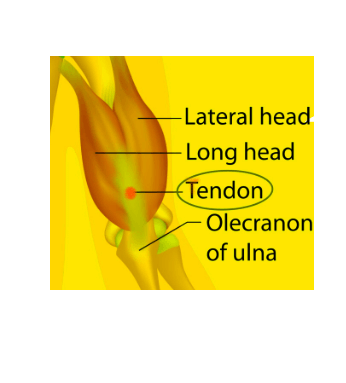Quick Overview
Triceps tendon is a strong, fibrous band of tissue that connects the triceps brachii muscle to the olecranon process of the ulna bone at the elbow. The triceps brachii muscle is the largest muscle in the upper arm and is responsible for extending the elbow joint. It is essential for performing activities such as pushing, pulling, and throwing.

Table of Contents
Anatomy
It is located on the back of the elbow, just below the triceps brachii muscle. It is about 2 inches long and is surrounded by a sheath of connective tissue called the paratenon. The paratenon provides a blood supply to the tendon and helps to protect it from injury.
Rupture
It is a relatively rare injury, but it can occur in athletes who participate in sports that involve forceful extension of the elbow, such as powerlifting and weightlifting. A triceps rupture can also occur in people who have a history of triceps tendonitis or who have weakened triceps muscles.
Symptoms
Symptoms of rupture includes;
- A sudden, sharp pain in the back of the elbow
- Difficulty extending the elbow
- Swelling and bruising in the back of the elbow
- A palpable defect in the tendon
Triceps Tendonitis
Tendonitis is an inflammation of the tendon. It is a more common injury than a tricep tendon rupture. It can be caused by overuse of the triceps muscle, such as from repetitive activities such as tennis, golf, and weightlifting. It can also be caused by a direct blow to the elbow.
Causes
It is most commonly caused by overuse of the triceps muscle. This can occur from repetitive activities such as tennis, golf, and weightlifting. It can also be caused by a direct blow to the elbow. Other possible causes of triceps tendonitis include:
- Age: It is more common in people over the age of 40.
- Trauma: A traumatic injury to the elbow, such as a fall or a car accident, can cause tendonitis.
- Bone spurs: Bone spurs are bony growths that can form on the bones of the elbow joint. They can cause inflammation by irritating TT.
- Impingement syndrome: Impingement syndrome is a condition in which the triceps tendon is pinched between the humerus (upper arm bone) and the olecranon (the bony prominence at the back of the elbow). Impingement syndrome can cause tendonitis.
Signs and Symptoms
The most common sign and symptom is pain in the back of the elbow. The pain is typically worse with activity, especially during activities that involve extending the elbow. Other signs and symptoms may include;
- Swelling and tenderness in the back of the elbow
- Crepitus (a popping or grinding sensation) in the back of the elbow
- Difficulty extending the elbow
Read also Patellar Tendon
Diagnosis
This condition is typically diagnosed based on a physical examination and medical history. Imaging tests, such as an ultrasound or MRI, may be ordered to confirm the diagnosis and assess the severity of the injury.
Treatment
Treatment option typically involves rest, ice, compression, and elevation (RICE). Physical therapy may also be recommended to help strengthen the triceps muscle and improve range of motion. In some cases, nonsteroidal anti-inflammatory drugs (NSAIDs) or corticosteroid injections may be prescribed to help reduce pain and inflammation.
If conservative treatment is not effective, surgery may be considered to repair the triceps tendon. However, surgery is rarely necessary for triceps tendonitis.
Prevention
The best way to prevent triceps tendonitis is to avoid overuse of the triceps muscle. This can be done by gradually increasing the intensity and duration of your workouts, and by taking breaks from repetitive activities. Other things you can do to help prevent triceps tendonitis include;
- Warm up before exercise and cool down afterwards
- Stretch your triceps muscle regularly
- Maintain a healthy weight
- Use proper lifting techniques
Questions
Q: How long does triceps tendonitis take to heal?
The healing time for triceps tendonitis varies depending on the severity of the injury and the individual’s healing process. Most people recover within 6 weeks to 3 months, but some people may take longer.
Q: What are the risks of triceps tendonitis surgery?
The risks of triceps tendonitis surgery include infection, bleeding, nerve damage, and wound healing problems. In rare cases, the tendon may rupture again after surgery.
Q: What can I do to prevent triceps tendonitis?
To help prevent triceps tendonitis, you can:
1- Avoid overuse of the triceps muscle.
2- Gradually increase the intensity and duration of your workouts.
3- Take breaks from repetitive activities.
4- Warm up before exercise and cool down afterwards.
5- Stretch your triceps muscle regularly.
6- Maintain a healthy weight.
7- Use proper lifting techniques.
Q: What is the best way to treat triceps tendonitis?
The best way to treat triceps tendonitis depends on the severity of the injury. In most cases, treatment includes rest, ice, compression, and elevation (RICE). Physical therapy may also be recommended to help strengthen the triceps muscle and improve range of motion. In some cases, nonsteroidal anti-inflammatory drugs (NSAIDs) or corticosteroid injections may be prescribed to help reduce pain and inflammation.
If conservative treatment is not effective, surgery may be considered to repair the triceps tendon. However, surgery is rarely necessary for triceps tendonitis.
Q: What are the long-term complications of triceps tendonitis?
Long-term complications of triceps tendonitis include:
1- Chronic pain
2- Weakness in the triceps muscle
3- Stiffness in the elbow
4- Recurrence of tendonitis
